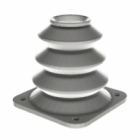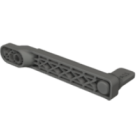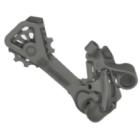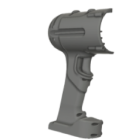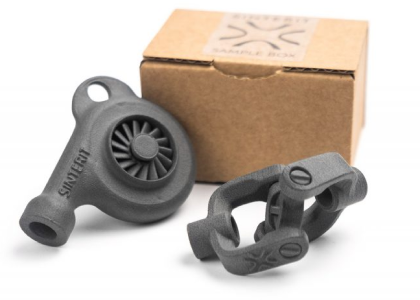Where 3D printing is used
3D printing is no longer a fringe technology reserved for prototyping labs and hobbyists. With advanced systems like Selective Laser Sintering (SLS), additive manufacturing has moved far beyond the lab — delivering industrial-grade results in compact, accessible formats. Today, it plays a critical role across industries, product development stages, and manufacturing environments. From mass customization to functional part production, the reach of additive manufacturing continues to grow, offering unmatched versatility and responsiveness to modern production needs.
This section explores the key sectors and real-world applications where 3D printing is already making a difference — and where it’s poised to expand even further.
Industrial manufacturing
One of the most significant areas where 3D printing is used is in industrial manufacturing. Here, it’s not just about prototypes anymore — it’s about tooling, jigs, fixtures, and even end-use parts. Technologies like Selective Laser Sintering (SLS), MJF, and DMLS enable manufacturers to create durable, isotropic parts with tight tolerances and excellent repeatability. SLS in particular stands out for its ability to produce functional polymer parts that can replace injection-molded components — perfect for low- to medium-volume production and on-demand spare parts. For small to medium production runs, additive manufacturing can even replace traditional injection molding, eliminating tooling costs and reducing time-to-market. Compact SLS systems allow manufacturers to keep tooling, prototyping, and production under one roof, reducing outsourcing and logistics costs.
Industries such as automotive and aerospace rely on 3D printing for lightweight structural components, aerodynamic testing models, and production tools. In these sectors, material performance and geometric freedom are critical — and additive delivers both.
Medical and healthcare
In healthcare, 3D printing is revolutionizing the way medical devices are designed, tested, and manufactured. It’s used to produce custom implants, prosthetics, surgical guides, and anatomical models for pre-operative planning. For example, using MRI or CT scan data, a patient-specific implant can be modeled and printed with precision that matches the individual’s anatomy.
Biocompatible materials and the rise of medical-grade additive technologies have made it possible to manufacture parts that meet strict regulatory standards. Among these, SLS printing with PA12 and TPU materials provides the perfect balance of strength, flexibility, and patient safety, making it ideal for prosthetics, orthotics, and surgical guides. In dentistry and orthodontics, digital workflows powered by 3D printing have become the norm — especially for crowns, clear aligners, and surgical models.
Consumer products and electronics
3D printing is also widely used in consumer goods design and short-run production. Brands utilize the technology to rapidly prototype and iterate new products — everything from headphones and wearables to kitchen appliances and sports gear. Designers value the ability to test aesthetics, ergonomics, and functionality in physical form before committing to large-scale production.
Additionally, customized components — from smartphone accessories to luxury eyewear — can be efficiently produced using SLS printing, which provides excellent surface finish, strength, and design freedom without expensive molds. This helps brands differentiate themselves through personalization without incurring traditional manufacturing penalties.
Education and research
Educational institutions at all levels — from elementary schools to advanced research labs — use 3D printing to teach, experiment, and innovate. It provides a hands-on way to understand design thinking, digital fabrication, and engineering principles. Universities often integrate 3D printers into their STEM curriculum, while researchers use them for lab equipment, experimental setups, and advanced materials research. Desktop SLS printers are increasingly popular in research institutions because they allow teams to produce high-quality mechanical parts directly on campus, supporting both prototyping and testing.
Additive manufacturing is also invaluable for product development in academic startups and incubators, where speed and cost-efficiency are crucial.
Architecture and construction
Although still emerging, large-scale 3D printing is increasingly used in the architecture and construction sectors. With specialized machines capable of extruding concrete or polymers, entire walls, facades, and even full structures can be printed directly on-site. This opens new possibilities for sustainable and cost-effective housing, infrastructure, and complex formwork.
Construction 3D printing also reduces material waste and labor requirements, which is especially valuable in areas with limited resources or skilled labor shortages. Beyond large-scale printing, SLS technology is also used in architecture for model making and complex structural prototypes, helping architects and engineers visualize and test their designs before construction.
Art, fashion, and design
Additive manufacturing enables unparalleled design freedom, making it a favorite among artists, designers, and fashion creators. Complex, organic, or highly customized geometries — impossible with subtractive techniques — can be easily achieved. This is especially popular in jewelry, lighting, footwear, and haute couture, where aesthetic detail and form experimentation matter.
Materials like resins, elastomers, and even metal powders are commonly used to bring artistic visions to life with both precision and durability. Powder-based SLS printing is especially valued in this field for producing complex organic shapes and textured surfaces that are difficult to achieve with other methods.
Summary: 3D printing is used for…
- prototyping and design validation in virtually every industry,
- customized products such as orthotics, dental aligners, and lifestyle accessories,
- functional parts in automotive, aerospace, and consumer goods,
- education and experimentation in universities and R&D labs,
- tooling and jigs to streamline traditional manufacturing workflows,
- large-scale construction projects using concrete and polymer extrusion.
3D printing is no longer a supporting technology — it’s becoming a central pillar of digital manufacturing strategies worldwide. To explore each of these use cases in more depth, visit Applications of 3D printing or learn more about choosing SLS technology.
Explore also
- What is print 3D? Concept of 3D printing
- What does “3D printed” mean?
- Example of 3D printing
- How does 3D printing work?
- Slicing in 3D printing
- What do you need for 3D printing?
- 3D printing benefits
- Is 3D printer dangerous? Understanding the real risks
- 3D printing issues
- 3D printing history
- 3D printing facts
- Who uses 3D printers? Not just for engineers anymore
- 7 common 3D printing myths
Related categories
 Austria
Austria  Bosnia and Herzegovina
Bosnia and Herzegovina  Bulgaria
Bulgaria  Croatia
Croatia  Czech Republic
Czech Republic  Denmark
Denmark  Estonia
Estonia  Finland
Finland  France
France  Germany
Germany  Greece
Greece  Hungary
Hungary  Ireland
Ireland  Italy
Italy  Latvia
Latvia  Lithuania
Lithuania  Poland
Poland  Portugal
Portugal  Romania
Romania  Slovakia
Slovakia  Slovenia
Slovenia  Spain
Spain  Sweden
Sweden  Switzerland
Switzerland  United Kingdom
United Kingdom  Ukraine
Ukraine  China
China  Hong Kong
Hong Kong  India
India  Israel
Israel  Japan
Japan  Malaysia
Malaysia  Philippines
Philippines  Saudi Arabia
Saudi Arabia  South Korea
South Korea  Taiwan
Taiwan  Thailand
Thailand  Turkey
Turkey  United Arab Emirates
United Arab Emirates  Egypt
Egypt  South Africa
South Africa  Tunisia
Tunisia  Canada
Canada  Mexico
Mexico  United States
United States  Brasil
Brasil  Colombia
Colombia  Australia
Australia  New Zealand
New Zealand 



